We take a look at a stepping stone into mythos
Dune is massive, and it’s only going to get bigger. It’s a hot property, with popular movies and TV shows and games — even the books are having a resurgence. I’m enamored with it. I’m drawn into the history of the future, of the art and design, and of the characters that are found within. I’m becoming a Dune-head, if that’s a word.
But you know what I’m not? An MMO-head. I don’t really play them due to lack of time, lack of friends who play, and general insane amount of understanding that is needed to learn new lore. But when I was approached by the developers of Dune: Awakening to have a look at the latest build of their game at Summer Game Fest, I felt an Arrakis-level warmth in my chest that pulled me forward. “I’m not an MMO guy, why am I signing up for this,” I kept asking myself. After the demo, though, I had changed my tune to “why am I not an MMO guy yet, why didn’t I sign up for this earlier.”
The demo we saw at SGF was a mid-game slice. It’s a survival- and crafting-based MMO, in that we can run things alone but cane zoom out to realize we’re actually part of a much larger world. This world, Arrakis, is slightly different than the one we’re used to seeing though. This is an alternate history of Arrakis, a sort of “what if” scenario where Paul Atreides doesn’t exist, where Leto is still alive and where Jessica had a girl instead of a boy. This is the history of what should have happened, so to speak. All it takes is for one thing to have happened — #NoPaul — and things unroll quite differently in this world. There is a huge “war of assassins” happening, with House Atreides and House Harkonnen engaged in some wild battles and sneaky murders back and forth, throwing the planet into an even chaos instead of the one-sided obliteration of the main timeline. The Fremen are still there, as are all sorts of factions and sides; it’s a lot to keep up with, but also a lot of freedom to play, and the dev team has promised plenty of narrative elements and story CG to flesh out the plot and keep us in the loop.
The game is huge. Not only are we in an area that’s sort of a dungeon (in an MMO sense) but that place is within a huge region we can navigate and take on missions and advance the plot, and yet THAT area is set within and even bigger zone on the planet where the MMO aspects really kick in. But before we’re shown the true majesty of the planet, we need to start small. So, back to the “dungeon.” We start our tour by having our created character jump into an ornithopter. From here, they can fly around from place to place to place, biome to biome. It’s not just sand and brown rocks on Arrakis, surprisingly, but it’s not like we’re going to find a rainforest. Instead, the developers have focused on pushing what makes the planet special to nth degrees. Instead of a rainforest we may find a spice field, instead of an ocean we’ll adventure through an underground mine, and instead of a desert we’ll find, well, a desert. On Arrakis, elements and industry and darkness and belief are biomes.
The current area we’re visiting is an iron-rich biome, so it’s red with black chunks protruding out. It’s clearly been mined already, but we still need to collect some resources based on our mission requirements. Iron sand emits a sort of sparkle, and so grabbing that and taking it back to our base is crucial — but we need to be careful not to make noise or else WORMS. In the area we find shipwrecks, which provide yet more resources. They’re currently leaking radiation, though. Every time something falls from the sky into the planet, especially after a cool scene of a ship getting bombarded and accelerating down in the distance, that usually means a lot of radiation and a heck of a lot of loot. And, because the planet is in this perpetual state of war, that means that stuff is always falling. Different items and resources are in different locations, so for example shipwrecks have mechanical parts, guns, etc. An interesting situation takes place when the developers are showing us around a base camp. We overhear someone mention on a radio that their faction or house took down a ship, which gives us a queue to look up into the sky and see the ship exploding and crashing down.
Surviving radiation requires special suits, which our demo character certainly doesn’t have yet, so they need to move along. That’s when we’re shown some of the interesting traversal aspects of the game. As we come to an outcropping of rocks and cliffs, we engage in more than just running — now we can see the verticality, through both climbing and jumping and equipment that can send us higher. We’ve made a lot of noise, and at the top of the cliffside is where we get our first look at the monolithic sand worms. Off in the distance the sand starts to move, utilizing dynamic displacement. This causes the entire landscape to shift as the beast god shows itself. It’s a sight to behold when seeing one in the distance, and a level of tension and fear to try and escape before it reaches the player. A quick note we’re told is that when we’re going after loot on a shipwreck we need to get there fast, or else waiting too long will give the opportunity for one of the worms to eventually gobble it up. Thankfully, if we want to make a quick getaway we can fast travel to our vehicles, which we can set as a respawn point.
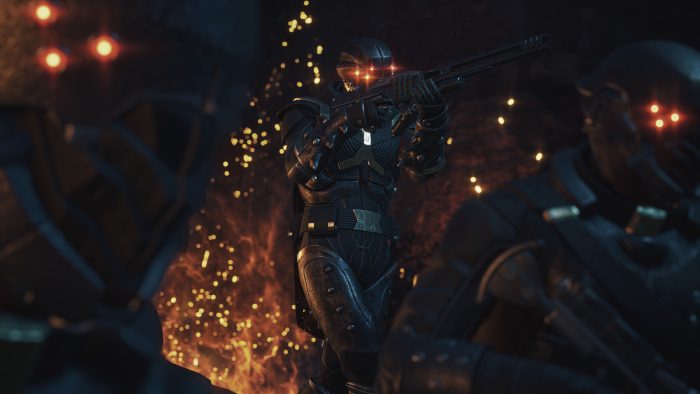
The game includes different factions in the world, and each biome has unique ones. They each have different abilities and values, different goals that guide them, different talents they can put to use. The developers explain that though we start up the game alone alone, we can align ourselves to factions and eventually the houses of Atreides or Harkonnen. Depending on who we align with, we can get access to their schematics to develop items, build buildings, etc.
The character development system focuses a little differently than in other MMOs. When creating a character we also select a Mentor. We work with them, train with them, and eventually they accept us and teach us their ways. The game has no class system — we can learn and be everything, and using the upgrade trees we can choose our active and passive abilities like combat, exploration, mining and crafting.
Once our feet are wet with character mobility and general task management, the developers show us a new biome, a cave-like canyon. It’s dark, moody, and we need the lights of the vehicle to see in front of us. The area contains a lot of variety of what we can do, and who we can do it with, based on its type of “zone.” There are three types of multiplayer interaction zones in the game: peace (we can’t fly, can’t shoot), a light PvP zone, and the War of Assassins, which is full PvP. As far as the PvP, we can take down enemies and harvest their water (there’s water in blood, yuck). The game also has a variety of attacks, from slashes to charged attacks, dodges, a flying knee, etc. It’s a little heavier on the melee side, as players are intended to get up close and really personal.
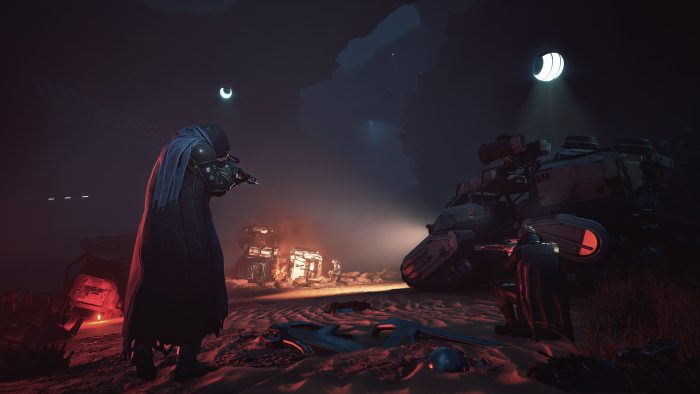
These zones are the regions that the maps continue to layer into, and it’s how we players will figure out what we want to do, where to go, and how comfortable we are with the MMO side. The smaller areas where we can’t attack other players generally work more like a single player experience, and engagement with other humans leads to exploration, trading, and conversation rather than battles. These tend to be 8×8 kilometer maps that focus on some biomes and bases, and house about 40 live players. We can fly to the edge of a map, leaving it to go to whole other map areas, include city hubs, villages and all new missions, etc.
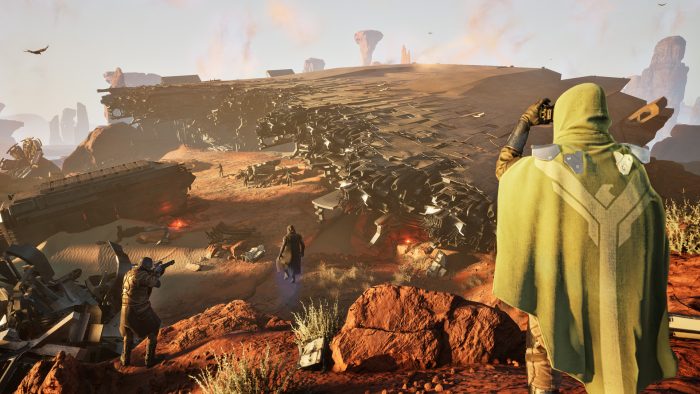
As our demo barrels towards its finish, we head to the deep desert, which is the big, giant map at the center that contains all of the MMO and PvP action. It rakes in at about 460 square kilometers and has space for hundreds of players. The area has massive spice flows and massive worms, and where guild vs guild events and battles happen. So that the giant map doesn’t get too one-sided, each week a coriolis storm comes through and wipes everything out. This also means that the map changes and becomes fresh, with new sand shifts, item locations, and areas hidden or revealed. But we can also lose everything in the storm, so it will be important to get everything out and prepare for the next week.
Dune: Awakening has a lot of onion skin to it. As we pull the layers back, we find more and more interesting facets of gameplay. These will be important to engage those of us who prefer single player experiences while still satisfying the more core MMO audience, and with the idea of zones and biomes and map design it may just help guide us towards the locations we’re most comfortable with staying in.
Dune: Awakening doesn’t have a release date yet.
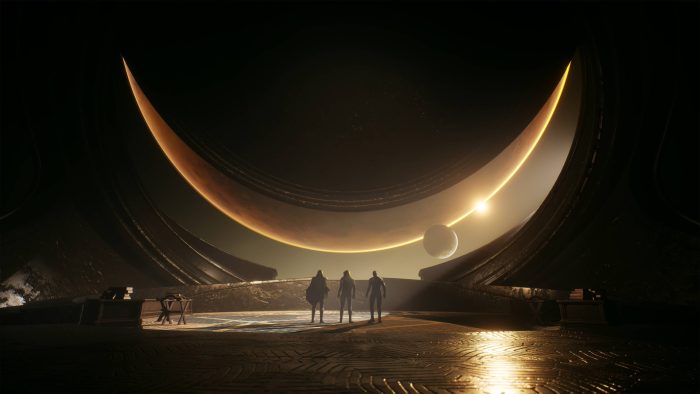
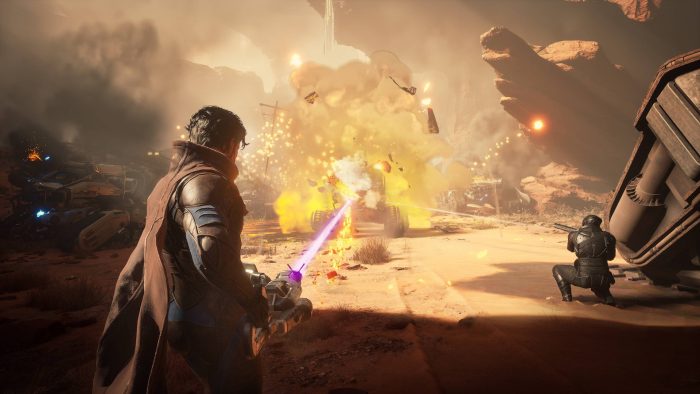
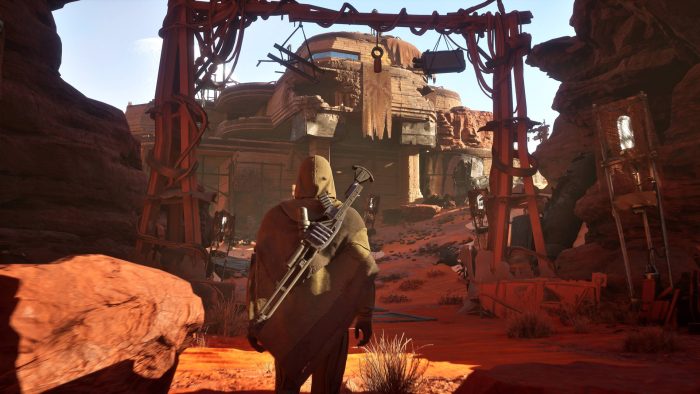

![[Preview] Dune: Awakening sends us into the depths of an alternate Arrakis](https://www.sidequesting.com/wp-content/uploads/dune-awakening-hands-on-preview.jpg)

No Comments